Hyundai Elantra N Vs Hyundai Kona N: Hot or Hotter

We are big fans of the latest batch of Hyundai N cars.
The Elantra N had us smitten at its first drive, on track at the challenging Sonoma Raceway and along the fun roads surrounding it. Same goes with the Kona N, an unlikely mini-SUV-turned-hot-hatch. More recently, the Elantra N outshined the Volkswagen GTI and Honda Civic Si in a three-car shootout, its combination of pugnacious performance and tremendous value earning it the title.
With both N cars being so similar, it’s an all-too easy question: which one is best? During a recent event with both, at one of North America’s fastest circuits—more on that soon—we refamiliarized ourselves the Elantra N and Kona N, discovering what we love about them all over again. If you’re in the market for either, there are a few important differences that might sway you either way—but let’s be clear from the beginning, there’s no wrong choice here.
Get a Quote on a New Hyundai Elantra or KonaPowertrain and Driving Feel
Elantra N: Both cars use the same 2.0-liter turbocharged four-cylinder engine, an evolution of the powerplant that debuted in the Veloster N (RIP). Hyundai’s team of engineers has turned up the wick a bit here, unlocked a single extra pony (to 276 horsepower) and 29 pound-feet (now totalling 289 lb-ft). Both cars also send that power exclusively to the front wheels.
From there the N twins begin to diverge. The Elantra comes standard with a six-speed manual transmission, with an eight-speed, wet-type dual-clutch auto available as an option. Kona buyers don’t get the choice to row their own. Opting for the DCT also adds a fun little push-to-pass button on the wheel. The appropriately-named N Grin Shift adds an extra 10 horsepower and sharpens throttle response and shift times, in short 20-second bursts. It’s a hoot.
No matter the number of pedals, the Elantra uses an electronically-controlled limited-slip differential, helping the front wheels lay down the power while also handling turning duty. There are wide 245-series Michelin Pilot Sport 4S tires at all four corners, making the Elantra stickier than a koala dipped in Gorilla Glue. Hyundai’s also lowered and stiffened the suspension, and thrown a serious-looking brace bar behind the rear seats. All told, the N’s rigidity is up 29-percent over lesser Elantras.
And it feels it. On the road, the Elantra is tight and controlled, easy to read at any speeds. There’s solid resistance to lean against from the right-sized steering wheel, as Hyundai has figured out the dark art of tuning electronically-assisted power steering. Would we like more feedback? Yes, but what’s there is consistent, and that builds trust early. The selectable drive modes allow this maniac to calm down on the road. The suspension is still stiff on its softest setting, but it’s wholly acceptable for around-town use.
On the track, the Elantra starts to distance itself from its upright cousin, and never looks back. This is a car that’s happy to rotate with a lift off the throttle. Be smooth with the inputs, however, and the Elantra’s longer wheelbase keeps it stable through Canadian Tire Motorsport Park’s high-speed corners. That stability in tandem with the wider tires and quicker steering rack makes the Elantra N an absolute joy around the track. This is a guided missile, quick enough to embarrass much pricier machinery, yet tidy enough that the driver can glean where to make up time each consecutive lap. Lots of grins, indeed.
Kona N: Two-liter turbo? Check. Dual-clutch transmission? Check. Trick, racing-inspired front suspension design paired with smart e-LSD? Checkity check. The Kona N goes harder than any other sub-compact SUV out there, packing serious hardware under those pumped-up looks. Both Ns ride on 19-inch wheels, though the Kona runs 235-section Pirelli P Zeroes.
Both cars share an effervescent urge to rev. With the Fiat 500 Abarth retiring on this side of the Atlantic, the N cars have firmly taken the title of best-sounding four-cylinder models out there. There’s a rorty, aggressive note coming out of those twin cannons out back that encourages drivers to ride gears out and make regular use of those wheel-mounted paddle shifters. The DCT reacts quickly and cleanly, with little low-speed jerkiness. Left to its own devices, the transmission isn’t afraid to hold gears right to redline.
Yes, there’s some piped-in audio, but that’s only providing more of what the car produces on its own, not an altered note.
Like the Elantra, the Kona’s brake pedal is wonderfully progressive, offering lots of bite from early in its travel and just getting better the more pressure is applied.
Unlike the Elantra, the Kona doesn’t sit any closer to terra firma. Gotta keep that SUV-like clearance, after all. Hyundai has had to stiffen the suspension at both ends to compensate, which can make the Kona get a little pogo-esque over very rough roads.
Hyundai sees the Kona as the (comparatively) softer N car, and that’s clear from behind the wheel. There’s just the faintest bit of squidge when the driver applies steering lock, as if the Kona needs a split second longer to commit to the corner. The narrower, less aggressive Pirelli rubber also feeds into this feeling.
This is all most noticeable on the track, however. On public roads, the Kona N’s short wheelbase and torquey engine make it hilarious fun to chuck around. The higher seating position gives the driver a clear view of where that pointy front end is heading, a boon during quick direction changes. With shorter overhangs and more ride height, there’s less worry about snagging bodywork on potholes or rough roads, as well. Basically, you can drive the Kona N like your own personal rally car, and it will entertain, all without having to break the speed limit or its own limits of adhesion to do it.
Bottom Line: On the road, there’s little that separates these two. In fact, we very slightly prefer the more playful, tossable nature of the Kona N. If you’re going to be doing any more serious track driving than autocrossing, however, we have to recommend the Elantra N. It’s simply one of the most accomplished cars we’ve tracked under six figures.
Interior and Cargo Space
Elantra N: Hyundai has fit serious, highly-bolstered bucket seats in the Elantra N. These leather-and-Alcantara wonders hold the front folks firmly in place during high-g maneuvers, and they look fantastic replete with light-up N badge.
Beyond those fantastic front buckets, the newer Elantra’s cabin is a more sharply styled, angular place to spend time. Both cars are light on frills: there’s a lot of black plastic here, with only the contrast stitching and matching blue wheel buttons the clearest signs of the performance intent. DCT-equipped models (the Elantra pictured here is a manual) gain an inconspicuous red NGS button on the wheel, which enables the 20-second N Grin Shift cheat code.
The beauty of vehicles like this is the promise of continued day-to-day usability. This is where the Elantra stumbles slightly. The red lattice work behind the rear seats gives it that wonderfully mobile tail on the track, but it kills the ability to load longer items into the car. There’s more rear legroom than in the Kona, but less headroom, and the lack of a rear quarter-window makes it a more claustrophobic space.
Kona N: As the older model of these two siblings, the Kona features a simpler, more straight-forward dashboard design. You’ll still find all the controls you need, with proper physical buttons to boot, but there isn’t the sense of design daring that exists within the Elantra.
The all-Alcantara front seats share a similar story. They’re not as aggressively bolstered as the Elantra’s thrones, but they should prove more comfortable over long distances. Female friends and family will appreciate these, in the words of this author’s wife, “actually account for hips.”
If you always loved the Veloster N but wanted something just a bit more normal, then the Kona N is your new hot hatch dream car. With four actual doors and a large hatch opening, it’s easier to slot folks and their stuff into the back half of the car. Rear legroom is at a premium, but there’s more headroom and more natural light thanks to larger windows. You’ve got the full 19.2 cubic feet (544 liters) of trunk storage here too, and that balloons to 45.8 cu-ft (1,297 L) with the rear bench folded flat.
SEE ALSO: 2022 Hyundai Elantra N First Drive Review: Big Grin MachineBottom Line: The Elantra is newer and more visually impressive. The Kona trades some of that wow-factor for a more inviting—if not technically roomier—second row, and a much more practical storage space.
Tech and Features
Elantra N: The Elantra’s pair of 10.25-inch screens is the sort of thing we expected of luxury cars not even a decade ago. They’re crisp and clean, and the central touchscreen is relatively snappy in its responses. Unique for N cars is a performance page, which tracks everything from real-time torque, g forces, and lap times. Here, pilots can also fine-tune their custom driving mode, an a la carte approach to shift speeds, throttle response, suspension stiffness, and more. Buyers also have access to wired Apple CarPlay and Android Auto here. Not to be outdone, the screen in front of the driver is customizable, and features some sweet animations as one cycles through the drive modes.
Unlike a six-figure sports car from Stuttgart, the Elantra N doesn’t exclude the expected modern safety and driver assists. Admittedly, you’ll have to opt for the DCT for the full complement. Still, you’ll find adaptive cruise control, lane-keep assist, automated emergency braking, and more. Stick to the stick, and the NGS button makes way for a rev-matching one, which executes perfect heel-toes should you not be in the mood.
Kona N: There’s nothing separating the Kona N’s pair of 10.25-inch screens except, well, actual air. It doesn’t have the dramatic single-panel layout, but functionally, this is the same setup as the Elantra. No surprise there.
Since it comes only with the DCT, the Kona N also includes the entire driver assist suite, too.
In its quest to differentiate these two performance options, Hyundai has made the Kona N fractionally fancier. Those everyday-friendly seats? Power-adjustable. There’s also a glass-panel head-up display (HUD) ahead of the driver. It’s pretty simple in its operation, but the shift light function is very helpful on track.
SEE ALSO: 2022 Hyundai Kona N First Drive Review: Pint-Sized Pocket RocketBottom Line: These two are essentially identical. You’ll sacrifice a few driving aids if you opt for the three-pedal Elantra (and NGS), but DCT versus DCT, it’s the same suite of assists. The Kona’s main advantage is the pop-up HUD.
Styling
Elantra N: The Elantra is already a pretty audacious shape in the compact car segment. For N duty, Hyundai’s engineers have given it the vehicular equivalent of a mohawk. There’s zero subtlety in the blacked-out front bumper, which visually sucks the low nose even closer to the ground. The brand’s bright red accents right along the lower edges of the car give it an added level of aggression, too. Top it all off with a sizeable rear spoiler, and the Elantra N looks like the barely-disguised track refugee that it is. With the old Civic Type R gone—and the new one featuring a cleaner design—Hyundai has the most outrageously-styled front-driver out there.
Kona N: There is something delightfully right about the Kona N’s four-square stance. Short in length but riding on thicc 235-series tires, the Kona N is muscular little mutant of a crossover. It’s a much fussier design, but we appreciate the sizeable rear wing and its triangle-shaped CHMSL, a nod to the Veloster N.
Bottom Line: This is an apples-to-oranges comparison, a traditional three-box shape versus a short, upright quasi-SUV. The Elantra is anything but subtle with its gaping black maw. Not to be outdone, the Kona is a delightful weirdo, all squinty face and extra-set-of-taillights rear. We like what we like.
SEE ALSO: 2022 Volkswagen GTI and Golf R First Drive ReviewPricing and Value
Elantra N: In America, the Elantra starts from $34,745, including $1,095 in destination charges. That’s a cracking deal for a bonefied performance model, and Hyundai doesn’t gouge with pricey options, either. You’ve got just two choices to add to the bottom line: the DCT (a $1,500 surcharge) or premium paint ($400). So even at the top end, the Elantra N is just $36,645.
Canada is the same story, though the numbers are naturally different. The basic price is $38,924 CAD, including the $1,725 in destination charges. Opting for the auto is a bit pricier at $1,600 CAD, but on the flip side, premium paints are only $200 CAD more—and there are more choices there, too.
Kona N: Hyundai keeps the Kona N pricing even simpler. There’s just one way to get it: fully loaded. Only paint can bump up the $35,495 ($41,824 CAD) price tag.
SEE ALSO: Honda Civic Si vs Volkswagen Golf GTI vs Hyundai Elantra N: Sport Compact ShootoutBottom Line: If you’re looking for the absolute cheapest way to get into an N, then the six-speed Elantra N is the ticket. Like-for-like the Kona N is pricier, which can be a little surprising for a smaller package, but you’re getting more versatility out of that high-riding hatchback shape.
Verdict: Hyundai Elantra N vs Hyundai Kona N
Like we said from the beginning, there is no loser here. Simply put, these are two of our absolute favorite performance models, regardless of price. Fun, involving, and still plenty useful in day-to-day scenarios, the 2022 Hyundai Elantra N and Kona N are righteous laugh riots on wheels.
The Elantra is the sharper drive, especially if you’re lucky enough to unleash it on a track. Forget anything anybody tells you about front-drive cars not being proper performance material. The Elantra N is a touring car for the road, a buzzy, infectious ball of fury. The next Type R has a lot of work ahead of it.
If you never plan on tracking it, the Kona N is the better daily driver. It’s softer, sure, but we’re talking comparatively: this will still run rings around nearly anything else south of $50,000. The tall hot hatch is less intimidating to grab by the scruff of the neck and chuck around, and it doesn’t have a bunch of metal lattice work behind its rear seats, so it’s just as practical as any other Kona. In fact, if it weren’t for those telltale red accents, it’d be hard to even clock a full-fat N on the road. Extra sleeper points for the Kona.
If you’re in the position to be considering either one of these, do it. Hyundai has proven the Veloster N wasn’t just a lucky one-off, crafting two hugely impressive performers that target slightly different parts of the market. These sorts of cars won’t be around forever, and we should cherish them while we can.
Become an AutoGuide insider. Get the latest from the automotive world first by subscribing to our newsletter here.

Kyle began his automotive obsession before he even started school, courtesy of a remote control Porsche and various LEGO sets. He later studied advertising and graphic design at Humber College, which led him to writing about cars (both real and digital). He is now a proud member of the Automobile Journalists Association of Canada (AJAC), where he was the Journalist of the Year runner-up for 2021.
More by Kyle Patrick




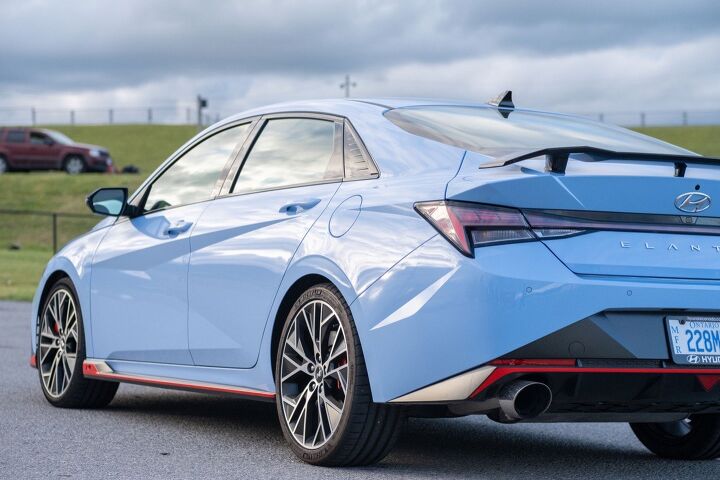

























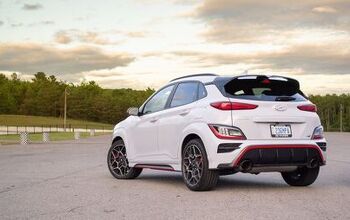


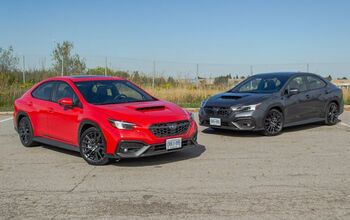


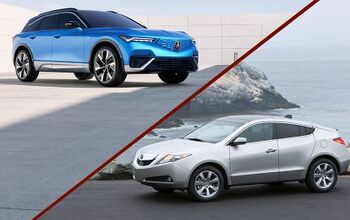


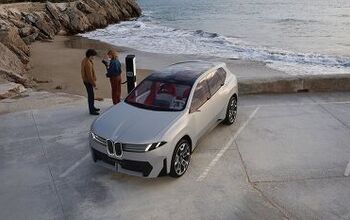


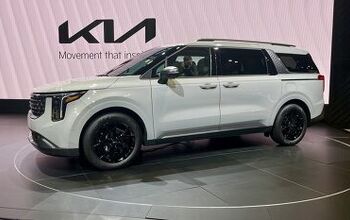


Comments
Join the conversation
Get back to me when AWD hits the showroom. That Kona would be a great all-season optio for us SnowBelters.
It annoys me that the US versions inexplicably lack Adaptive Cruise control and the heads up display. If the Kona had better interior materials I'd probably have bought it though. Trading my Edge ST (even though the Kona is ror sure faster and more fun) was just too much of a step down in quality since they were only going to give me 34k for my 2020 Fully loaded ST with 6k miles on it... a car that us currently (aside from the new vertical nav screen) listed for 55k+ new.